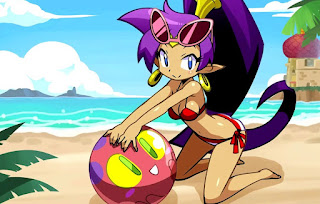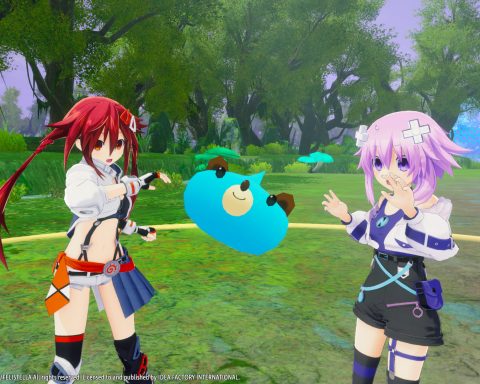The really nice thing about having Shantae released on the Nintendo Switch is that the Switch now has the entire collection running natively on it. That’s right: every single one of the glorious adventures of everyone’s favourite half-genie on the one console. Given how rare and expensive the original Game Boy release is now, it’s also nice to be able to play the game without dusting off the 3DS (where it was a Virtual Console release) or relying on less-than-legitimate means to play it. With that being said, I would have preferred a remake rather than a re-release for this one, I think.
Shantae does show its vintage at times. Back on the Game Boy Color, the development team at WayForward needed to make compromises. Because they wanted this to be a character-driven platformer, they needed to make the sprite appear big on the small, low-resolution screen, which meant that it was hard to see far around you as you played, and this both restricted the level design that the developers could throw at the players and, at times, made progress more difficult than it needed to be. The restricted number of sprites that the GBC could display simultaneously also meant development limitations that later Shantae titles were the better for being rid of. To spin this around: Shantae on the Game Boy Color was an excellent game, but it wasn’t the complete vision. It wasn’t what the creative lead, Matt Bozon, and his team really wanted to deliver with Shantae.
This release on Nintendo Switch does include the “GBA Mode” of the original Shantae cartridge, which is a nice touch. It cleans up the sprites and improves the depth of colour across the game. What it doesn’t do is change the screen ratio display. This GBA Mode was an actual feature that “enhanced” three Game Boy Color games (yes, just the three) when they were slotted into the GBA. However, that feature didn’t stretch the aspect ratio to suit the GBA’s widescreen, since that would have been an entirely different development project. It’s still the better way to play, but it doesn’t address the smattering of issues that inhibit the developer vision with Shantae.
To be clear: under any circumstances, I would have wanted the original version of the game to be preserved. Shantae is a cultural artefact that deserves to be looked at in the context that it was created. However, I also feel that as this Switch release is a “new” project (whereas the 3DS Virtual Console port was really a matter of getting the game to run on the hardware’s emulation), it would have been a wonderful thing for WayForward to actually go back and “remaster” the vision so it better suited what we’ve come to understand as the qualities of Shantae since. Of course, to do so would have been a bigger project, but I would have happily paid a premium for “Shantae Origins Remastered” (or whatever it would have been called) since the strength of this series – the coquettish protagonist, the Arabian Nights-style aesthetics, and the tricky, Metroidvania-like platforming – are all enhanced with more modern game development and art. This is still an excellent game and one of the best examples of early-era handheld platforming. It’s also a disappointing “re-release” given the opportunity that was there to bring the game that started it all for this series into the same ballpark as its sequels.
Now, with that out of the way, I still find this release of Shantae to be a delightfully refreshing thing, and the reason is simple: we don’t get many games that share the aesthetics and fantasy trappings as this one. As I noted in my review of the 3DS Virtual Console port: “At its core fantasy Arabia (and specifically the Arabian Nights that the genre mostly draws inspiration from) is a difficult one for many modern games developers. Because the stories tend to be loaded with sexual themes and a morality that is foreign to many of the main games markets, it can be difficult for developers to build an authentic fantasy Arabian tale without offending sensibilities. Games like Prince of Persia have achieved this over the years, and so too has Shantae. There’s a sexiness and exotic quality to the design and environments, but in a way that isn’t overly in the face. What’s even more impressive is that Game Boy Color games were almost never able to create characters or environments with any kind of personality, but WayForward was ahead of the curve then as it is now and Shantae is an example of the finest design the era could offer.”
Later Shantae titles would add a level of precise platforming and level design that this Shantae lacked, but the fundamental experience is all here, from the ability to turn into various animals to access otherwise inaccessible areas, to the dastardly Risky Boots, who remains one of the most entertaining and endearing villains in platformer history. The music remains as catchy and bright as ever – it’s right up there with the Donkey Kong Country soundtrack, as far as this genre is concerned – and when she dances, Shantae’s hips still don’t lie. Seriously. Early era sprites just don’t get more weirdly sensuous and mesmerising as Shantae here.
As a small, but not insignificant bonus, this release of Shantae includes a digital mini-art book, which includes sketches of the main characters (including one of Shantae’s absolutely impeccable back – no, really), and the sprite sheets for the game. Anyone with an interest in game development would do well to study this stuff closely – this is how you create a lot of personality and compelling aesthetics when you’ve got almost no hardware power to work with.
I know I’ve said this at least a dozen times now, but I do think Shantae deserves better than the platformer genre. She’s just too good of a character to waste on a genre that doesn’t really do narrative. Give her an RPG or something, WayForward. In the meantime, though, while this might not be the biggest release of the year, it’s certainly a worthwhile celebration of one of the most niche – but loved – platformer heroes out there.








